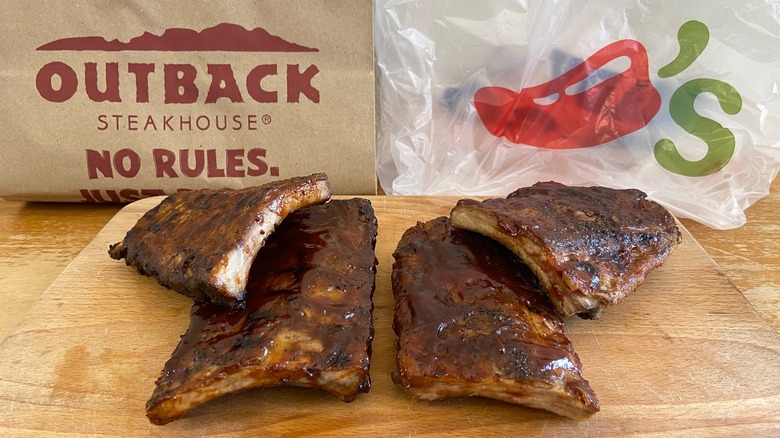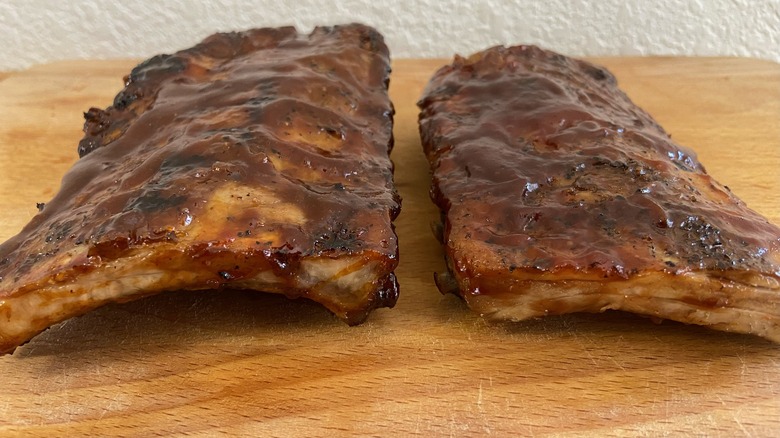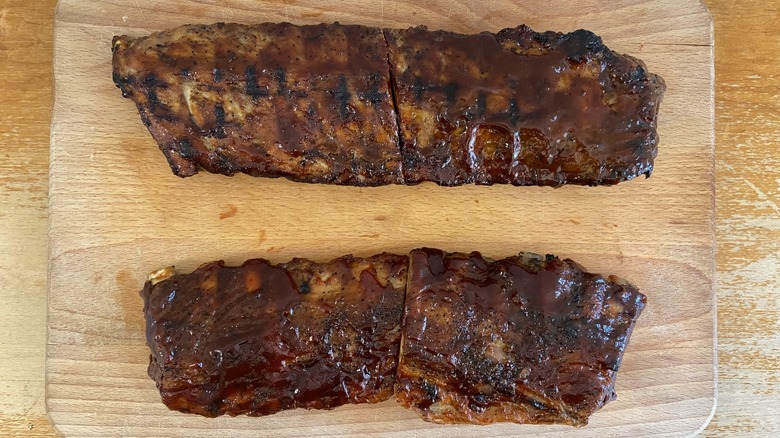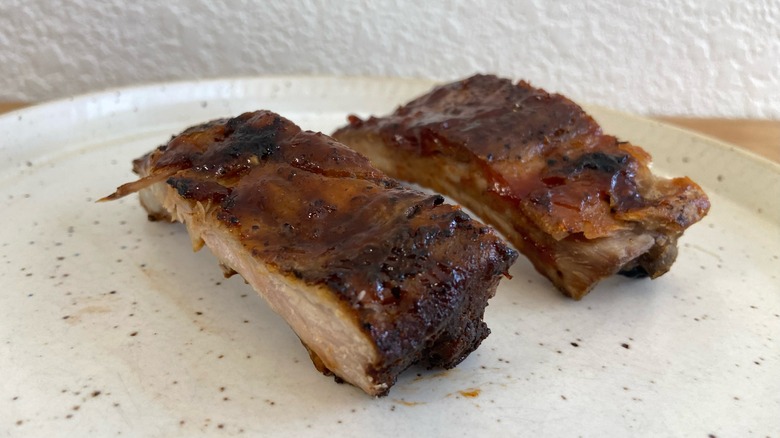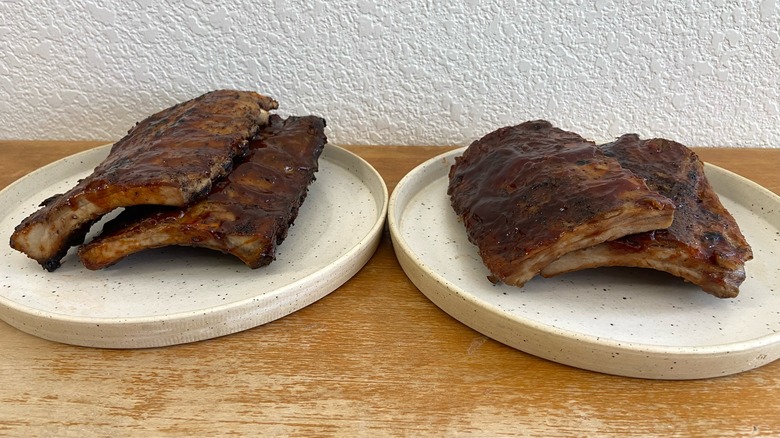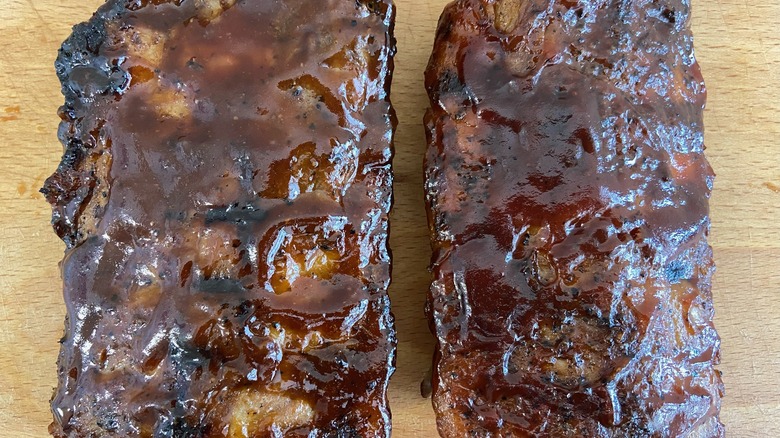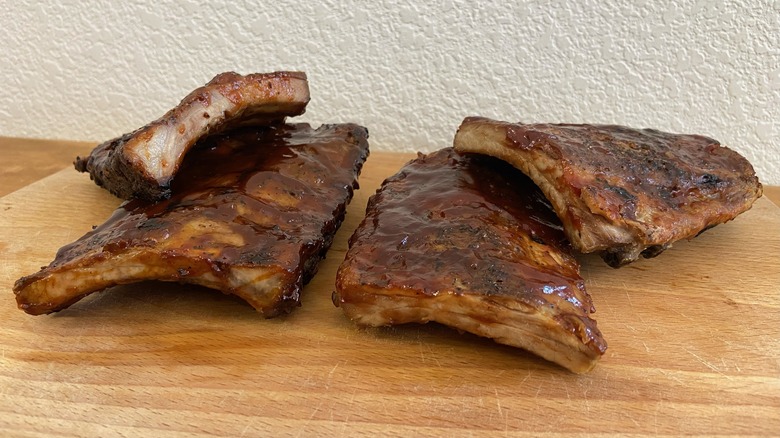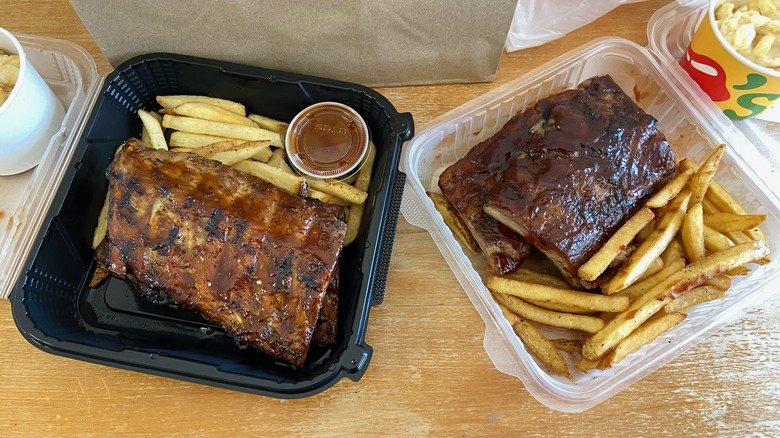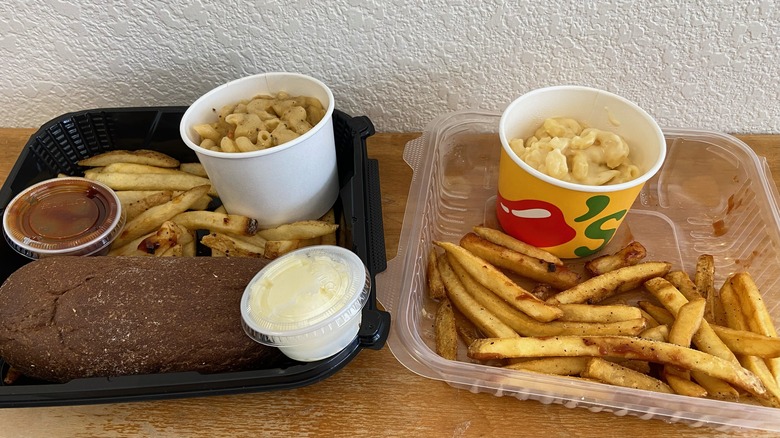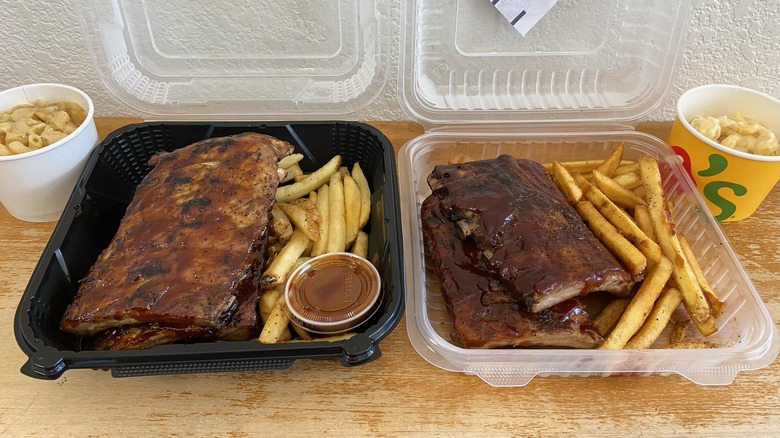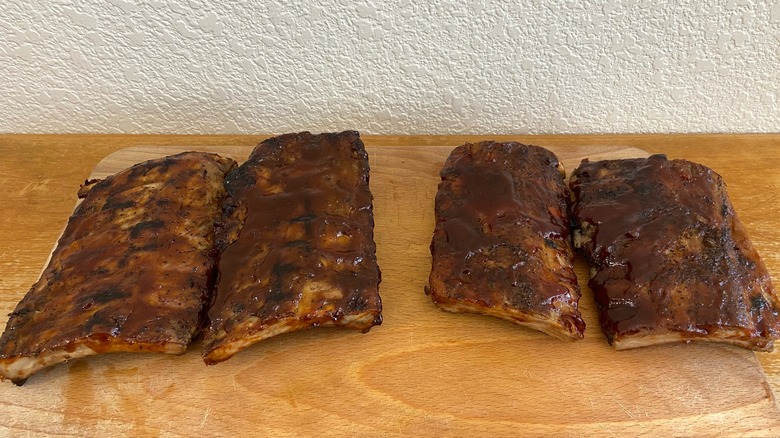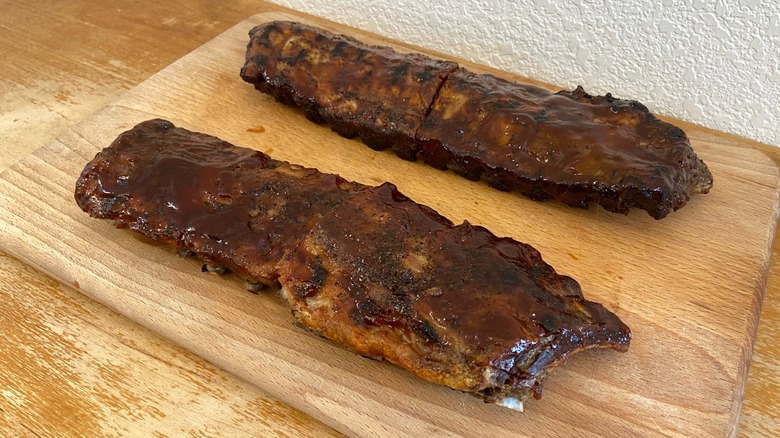Chili's Vs Outback Steakhouse: Who Has The Better Ribs?
While the menu at Chili's is plenty expansive, there's arguably no single dish more closely associated with the chain than the iconic Chili's Baby Back Ribs — courtesy, of course, of a catchy commercial jingle that's probably playing in your head this very second. But just because someone wrote a pretty solid song about them, it doesn't mean the ribs at Chili's are peerless. In fact, among the things that only regulars will know about Chili's is that ribs weren't even on its original menu. Enter Outback Steakhouse, with its own fascinating factoids and perhaps one of the first chains that comes to mind when it comes to big cuts of meat.
In order to determine who has the better ribs, I picked up full racks of ribs from both Chili's and Outback and pitted them against one another in nine categories. I opted for only barbecue sauce on my ribs from Chili's and for a side of mac and cheese rather than the default steamed veggies from Outback, so that the two orders would resemble one another as closely as possible. After taking into account all of my findings, one chain's ribs came out ahead. Here's how each rack of ribs performed head-to-head in all nine areas as well as my pick between the two classic sit-down chains for the superior ribs.
Which rack of ribs looks more appetizing?
A dish's looks might end up not mattering to some as long as it's delicious. But appearance is something that factors into the quality of food all the same — whether that's merely before a meal starts or a judgment that persists through a meal's entirety. Several scientific studies have even found that the more attractive a food is, the more likely a diner will enjoy its taste. That said, a full rack of ribs from Chili's and a full rack of ribs from Outback Steakhouse look pretty similar to one another, with only subtle differences between the two. Nevertheless, I found the ribs from Outback just slightly better-looking.
Both Chili's and Outback served their ribs separated into two halves, though Outback will plate a full rack of ribs in its entirety when dining in. Chili's, meanwhile, allows customers to flavor each half with a different sauce, hence separating a full order into two halves even in-restaurant. This is relevant because my ribs from Outback were satisfyingly easy to reassemble, whereas my Chili's rib rack halves appeared to be incongruous. Furthermore, my Outback ribs had a bit more of a charred look to them. Altogether, both sets of ribs looked appetizing, but based on an initial eye test, the ribs from Outback looked like the slightly superior product.
Which order of ribs is bigger?
In the above photo, my rack of ribs from Outback Steakhouse is on top, and my ribs from Chili's are on the bottom. While their sizes are somewhat comparable, it's clear that Outback's ribs are larger. In fact, I measured each rack of ribs to get a more precise idea of their sizes relative to one another. My Chili's ribs were about 11.5 inches by 3.5 inches, while the Outback ribs were about 11.75 inches by 3.75 inches.
Corroborating the larger size of the Outback ribs is the fact that Outback served me a higher number of individual ribs. For what it's worth, each chain provided one half-rack with one more rib than its counterpart, resulting in odd numbers of ribs. Whereas the full rack at Chili's consisted of 11 ribs, Outback's rack had 13 ribs overall. Based on both size and number of individual ribs, then, my order of ribs from Outback came with the overall larger slab of meat than the full rack at Chili's.
How much meat is on the bone at each chain?
While Outback Steakhouse's full rack of ribs may contain a higher quantity of rib bones, that's not necessarily a positive — with bones being inedible, the meatier rack of ribs is not necessarily the larger one but the one with the highest volume of meat after subtracting the total volume of its bones. That said, even taking into account its higher number of rib bones, Outback's full rack of ribs is altogether meatier than the ribs at Chili's.
On average, the bones left over from my Chili's ribs were as much as two times the size of my bones from Outback, with Chili's ribs having a flatter and wider shape compared to the faux-Aussie chain's skinnier and rounder bones. On each individual rib, I estimated that the fatter Chili's bones resulted in individual ribs that were about half meat, half bone. Outback's individual ribs, meanwhile, I estimated to be about two-thirds meat, one-third bone. On the whole, then, each individual rib at Outback is considerably meatier than an individual rib from Chili's.
How does the quality of meat stack up?
In appearance, size, and meatiness, Outback Steakhouse wins out over Chili's in this head-to-head rib battle. That said, those categories all cover outward appearance, not flavor. In this first flavor category, after analyzing the quality of the rib meat at both sit-down chains, I found that Chili's was my clear favorite.
First off, the rib meat at Outback was tougher than I would have liked. Ideally, I would argue, good rib meat should practically fall off the bone, both making it easier to physically separate meat from bone, and providing a pleasing textural experience while eating. Outback's rib meat came off of the bone easily enough, but sometimes tearing an individual rib off of the rack was a bit of a challenge. Plus, certain bites were a little too chewy, not necessarily to a significant degree, but enough that I found myself wishing the meat was more tender.
The rib meat at Chili's, however, was pretty much just as tender as I desired. Plus, that tenderness was matched with just a bit of heft, such that it provided each bite with a bit of satisfying meatiness before seeming to melt away fully. So, whereas Outback's rib meat left me wishing the chain had cooked its meat differently, Chili's prepared its full rack of ribs with its unique cooking method to relative perfection.
Who has better barbecue sauce?
Although Chili's has three sauce options — House BBQ, Honey-Chipotle, and Texas Dry Rub — I opted for the House BBQ sauce on both my half-racks. Outback Steakhouse serves its ribs with barbecue sauce and barbecue sauce only, and I wanted a sauce from Chili's that would be the most similar. That said, due to an online ordering snafu, I had to call the restaurant to place my order. Instead of asking which sauce I wanted, the Chili's employee asked something like, "Barbecue sauce on both halves?" suggesting that barbecue is its most popular option. With that said, the two chains' sauces are pretty different from one another. While I preferred the sauce from Outback, each has its merits.
Befitting the chain's overall zanier vibe, Chili's coats its ribs in a more sugary barbecue sauce. Accompanying that prevailing sweetness is a mild tang and even the mildest hint of spice, but a sugary molasses taste is dominant. Outback's barbecue sauce, meanwhile, is tangy first and foremost. After trying a finger-full of Outback's sauce on its own, my mouth was practically puckering. It's still subtly sweet and also spicier than the sauce at Chili's but hardly to a degree that many would consider outright spicy. Underscoring that flavor is a smokier rib seasoning at Outback. While I found the tangy sauce combined with that smoky seasoning from Outback to be superior, fans of pronounced sweetness, like in a homemade honey BBQ sauce, might prefer the one from Chili's.
How do they compare in the healthfulness department?
Unsurprisingly, neither the ribs at Chili's nor Outback Steakhouse makes for a healthful dietary choice. Of course, it's safe to assume most customers are cognizant and accepting of this fact. Ultimately, neither rack of ribs is healthier than the other. Rather, each offers its own distinct advantages — relative, of course, to its overall unhealthfulness.
A full rack of Baby Back Ribs at Chili's totals 1,480 calories, 106 grams of fat, of which 41 grams is saturated fat, 410 milligrams of cholesterol, 1,710 milligrams of sodium, 36 grams of carbs, 33 grams of sugar, and 98 grams of protein. A full rack of ribs at Outback has 1,430 calories, 91 grams of fat, of which 32 grams is saturated fat, 1 gram of trans fat, 345 milligrams of cholesterol, 2,310 milligrams of sodium, 53 grams of carbs, 2 grams of fiber, 42 grams of sugar, and 96 grams of protein.
Ribs at Chili's, then, are lower in sodium, carbs, and sugar, while providing a slightly larger quantity of protein. The ribs at Outback, meanwhile, include at least a little fiber, in addition to fewer calories, fat, saturated fat, and cholesterol. That said, even one gram of trans fat is noteworthy — the type of fat you're eating matters, and authorities like Harvard Medical School's Harvard Health Publishing consider trans fats unsafe in virtually any quantity. Overall, then, both ribs are pretty comparable, with the somewhat healthier choice simply depending on an individual customer's priorities.
Which is more customizable?
At both Outback Steakhouse and Chili's, customers can opt to customize their ribs in at least a couple of different categories. While I opted for full racks of ribs for the closest comparison possible, half orders are technically possible at both spots. That said, my local Outback does not offer a half-rack while Chili's does, so availability appears to be dependent on location.
By default, accompanying ribs at Outback are sides of fries and steamed veggies. For no additional charge, customers can substitute a baked potato, mashed potatoes, sweet potato, or rice, in addition to a few soups or salads. For various upcharges, additional sides include mac and cheese, Bloom Petals, loaded mashed potatoes, asparagus, and broccoli with cheese as well as some premium soups and salads. Further customization options include ranch or ketchup for free, plus cheese with or without bacon at an upcharge.
Meanwhile, ribs at Chili's come standard with fries and mac and cheese. Free alternatives include mashed potatoes, corn, asparagus, rice, beans, and broccoli, while for an upcharge customers can opt for loaded mac and cheese, garlic butter mushrooms, a house salad, or Texas cheese fries. While this selection of sides is just slightly smaller than Outback's, Chili's notably offers three rib flavors — House BBQ, Texas Dry Rub, and Honey-Chipotle — two of which can be added to a single full order of ribs. For its different flavors and seemingly wider availability of a half order, then, Chili's customization options win out overall.
Whose sides are best?
I ordered my Chili's ribs as-is, and my ribs at Outback Steakhouse with a side of so-called Steakhouse Mac & Cheese instead of steamed veggies. Both came with fries by default, and Outback also threw in a small loaf of its brown bread and butter. First off, the fries were pretty similar to one another — both thick cut and well-seasoned — though Outback had a more flavorful french fry recipe, including some sort of umami-forward seasoning. Outback's brown bread was pleasant, particularly due to a soft and flavorful butter, but hardly a game-changer.
The big difference in this category was the mac and cheese. Simply put, Outback's mac and cheese wasn't great. So scant were its cheese and other seasonings that in some bites I could taste a pronounced pasta flavor. And while it may not be a standard side option, I have a hard time imagining that regular old steamed veggies would have provided any sort of advantage. The side at Chili's, however, matched what I might consider the platonic ideal of chain restaurant mac and cheese. It was rich, cheesy, goopy, and saucy. It wasn't a unique take on mac and cheese by any stretch of the imagination, but a near-perfect execution of something akin to the best store-bought mac and cheese brands is almost always preferable to a chain restaurant trying to reinvent the wheel. Since both fries were almost equivalent, that mac and cheese single-handedly earns Chili's the win in the sides department.
Which menu item is a better value?
One of the first things anyone comparing an order of a full rack of ribs will likely notice is that Chili's offers its ribs at a significantly lower price point than Outback Steakhouse does. While prices may vary depending on location — franchisees for some Chili's and Outback locations might mean price discrepancies — the significant difference in price point between the two chains is more than likely to remain similar. At my local Chili's and Outback restaurants, just a few doors down from one another south of the Las Vegas Strip, a full rack of ribs at Chili's was $25.29 before tax, while my order at Outback was $32.99 pre-tax and before factoring in an upcharge for a side of mac and cheese.
Even if Outback's ribs are slightly larger and meatier, they aren't larger and meatier in quantities equivalent to their higher price point. Furthermore, Outback's lower meat quality and comparatively worse mac and cheese subtract from the overall value. At Chili's, then, a superior quality of meat, better sides, and an only just barely smaller portion of meat make for what is a plainly better deal.
The verdict: Who has the better ribs overall?
Between the ribs I ordered from Outback Steakhouse and my ribs from Chili's, I ended up landing on a clear favorite. That said, there are legitimate reasons an individual customer might prefer one over the other that personally weren't significant enough to sway me. For instance, someone for whom more meat is a decisive factor might go with Outback, whereas someone whose ideal barbecue sauce is sweet and sugary might default to Chili's. After weighing the advantages of each chain's take on the dish, I found that I enjoyed my rack of ribs from Chili's the most.
Outback, for what it's worth, did not have a bad showing. The size of its ribs and the flavor of its sauce combined with a smoky seasoning were clear high points. However, a lower-quality meat actively made it harder to enjoy those standout qualities. Meanwhile, even if Chili's came up a little short in the size and sauce departments, a clearly higher quality of meat meant that its sauce and seasoning — both still good — shined as bright as possible. Plus, if both items were the same price and came with the same sides, I still likely would have enjoyed the Chili's ribs more; but a lower price point and tastier mac and cheese really helped solidify a win for Chili's.
Methodology
I ordered full racks of ribs to go from both Chili's and Outback Steakhouse. While dining in may well be the superior experience in a vacuum, ordering takeout provided me with the unique opportunity to carefully suss out the minutiae of what makes each order of ribs distinct from one another. Plus, I picked my ribs up from the Chili's and Outback locations in the Las Vegas South Premium Outlets mall, just doors down from one another, so my orders were received at virtually the same time.
For each category, then, I directly compared my racks of ribs from Chili's and Outback to one another in a single sitting. Initially, my determination that Chili's has better ribs wasn't necessarily based on a summation of each category, but the simple fact I enjoyed them more. Knowing that, I then worked backward through my findings in each category to come up with the most detailed reasoning possible. However, though I may have worked backward to understand why my ribs at Chili's were better, I found that my rulings in each individual category did end up justifying that determination. Ultimately, winning a category was not as important as performance within that category — Chili's won out in large part due to how decisively it came out ahead in key metrics, whereas in others that it technically lost, it fell short by just a small margin.
